
North Woodley Coal Basin
This basin was situated just south of Murray's Bridge and Samuel Ashton (1773-1849) of nearby Woodley Mill owned the surrounding land.
Moreover, he was the occupier of Far Coal Pit Field adjoining the basin. The map does not show any pit buildings or a shaft but there would have been a shaft somewhere in the vicinity.
Coal from here would have been transported by boat the short distance southwards to Ashtons' Private Branch where it would have been used to power Woodley Mill.
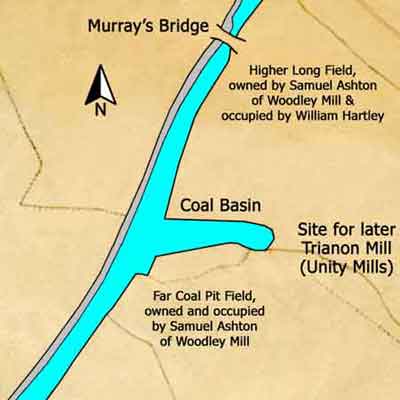
North Woodley Coal Basin
Lower Peak Forest Canal
Grid Ref: SJ 938 930
Tithe Map: 1841, Ref: EDT 63/2
Courtesy: Cheshire Archives & Local Studies
South Woodley Coal Basin
This was situated a short distance from North Woodley Basin and the land surrounding the basin was both owned and occupied by Samuel Ashton (1773-1849) of Woodley Mill.
The map shows pit buildings adjacent to the basin but it does not show the shaft. The shaft in Coal Pit Field was probably a ventilation shaft.
Similarly, coal from here would have been transported by boat to Ashtons' Private Branch to power Woodley Mill.
The Ashton family also owned Apethorn Mill (later Gee Cross Mill) and Throstle Bank Mill, both alongside the Lower Peak Forest Canal, and it is possible that coal from both basins was transported to them by canal.
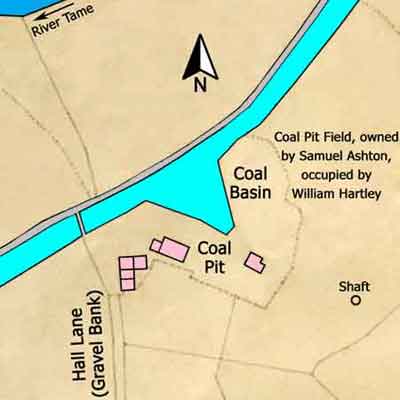
South Woodley Coal Basin
Lower Peak Forest Canal
Grid Ref: SJ 937 928
Tithe Map: 1841, Ref: EDT 63/2
Courtesy: Cheshire Archives & Local Studies
Ashtons' Private Branch
Mill owner Thomas Ashton (1775-1845) was the founder of the textile industry in Hyde. He was responsible for creating one of the largest and longest-lived textile companies and it was based in Flowery Field, Hyde.
When he died in 1845, he left the business to his two sons, Samuel Ashton (7 Nov 1804-Apr 1860) and Thomas Ashton (1818-98), along with the majority of his personal estate and property,
which was worth just under £60,000. In 1854 the brothers, Samuel Ashton and Thomas Ashton, formed Ashton Brothers & Co out of their father's business, maintaining its position of one of
the largest independent employers in Hyde until its sale to Courtaulds in 1968. The Ashton family founded several cotton mills in the area, including Apethorn Mill and Woodley Mill,
the latter being built in 1828. As well as their interest in textiles the family established a calico printing works and they also had coal-mining interests.
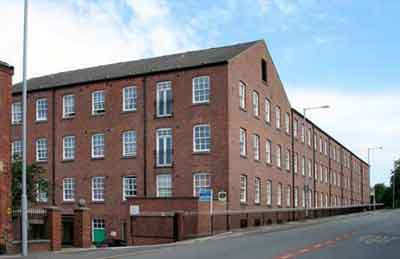
Woodley Mill, Aug 2007.
The brothers were especially noted for running cotton mills that did both spinning and weaving and this proved to be a successful venture when most mills specialised in either spinning or weaving but not both.
Management of the family business in Flowery Field, Hyde, then passed to Thomas Gair Ashton, 1st Baron Ashton of Hyde JP DL (5 Feb 1855-1 May 1933). He was the son of Thomas Ashton (1818-98) and Elizabeth Gair and he was born in Fallowfield, Manchester. He was educated at Rugby and University College, Oxford. He married Eva Margaret James in the St George Hanover Square Registration District in 1886 and he was raised to the peerage on the 28 Jun 1911. In 1892 he was awarded an Honorary Freeman of the City of Manchester and in 1923 he was awarded an Honorary Fellow of Oxford University. In addition to his expertise as an industrialist, he was also a philanthropist and Liberal politician. He was the Liberal MP for Hyde (1885/86) and Luton (1895-1911).
Ashtons' Private Branch was situated just beyond Woodley Bridge (Bridge 12), by Woodley Wharf and a short distance to the north of Butterhouse Green Tunnel. This branch is no longer extant but the surviving part of Woodley Mill has been converted into apartments and is listed Grade II, List Entry No. 1319640. The branch canal would have been used to receive raw cotton from Manchester and coal from the two Woodley Coal Basins.
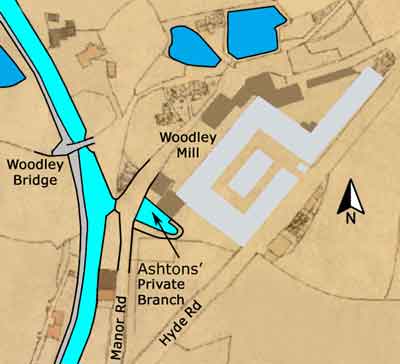
Ashtons' Private Branch
Lower Peak Forest Canal
Grid Ref: SJ 936 923
Tithe Map: 1841, Ref: EDT 63/2
Courtesy: Cheshire Archives & Local Studies
Pole Bank Hall
This hall is a situated a short distance to the north east of Woodley Mill on Stockport Rd, Werneth, Hyde.
It originally belonged to another branch of the Ashton family and it was built in c.1820 by Samuel Ashton (1773-1849).
By 1853 Benjamin Ashton (1813-1889), the third son of Samuel Ashton (1773-1849) was resident there. The hall is listed Grade II, List Entry No. 1356445.
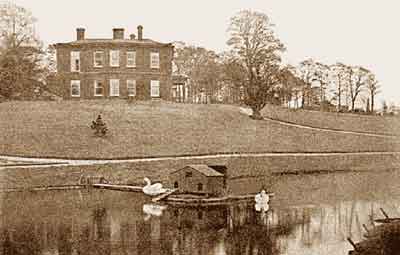
Pole Bank Hall, early 20th century.